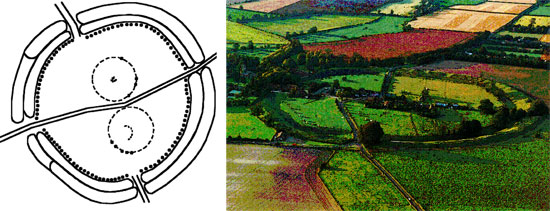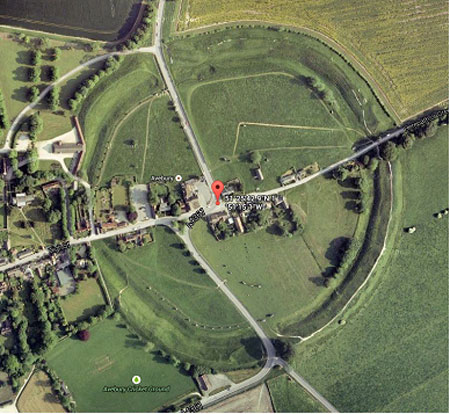As was briefly mentioned in the past classes, there is more than meets the eye when it comes to henge monuments. Henge monuments, typically made from stone or wood, were most popularly constructed between c.a. 3000 to 1500B.C. A henge is typically a (roughly) circular space, enclosed by a ditch and bank, with one or more entrances leading into the center. The earthwork bank was built on the outside edge of the ditch to serve as a defensive barrier.
Henges are generally believed to have been constructed as ceremonial centers, as a place for people to gather for religious rituals and communal activities. Stonehenge (found in England) is one of the most prominent henge examples, yet other examples may be found nearby. Of these, we find Durrington Walls, Woodhenge, and Avebury.
Curious to learn more (and knowing that we’ll discuss Stonehenge in class), I did a little research on Avebury. Avebury is located a little more than 17 miles due north of Stonehenge and covers an area of roughly 350 meters in diameter. When it was initially constructed, the banks were 27 meters wide and 6 meters high, and the ditch was 14 meters wide and 9 meters deep. Entrances into the center stemmed in each cardinal direction. The outer circle was comprised of roughly 100 stones, only 30 of which still remain today. Each of the inner circles, two in total, had a 100-meter diameter.

Figure 1: Plane-view (left) sketch showing the major features at Avebury Henge.
- The southern circle, made of 30 stones, had the Obelisk at the center; the Z feature (a line of six small stones) lies just to the west of the center and the Ring Stone is found a slight distance to the south of the Obelisk.
- As for the northern circle, only four stones still remain and it is believed that the circle may have not been a circle at all, but rather horseshoe-shaped with an opening in the southern edge. The Cove, three stones in a U-shaped arrangement that opens to the north-east, is found in the center of the northern circle.
All of the stones in the Avebury Formation are Sarsen stones, a type of sandstone block found locally just a few miles to the east in the Salisbury Plains in the Marlborough Downs. In contrast to the stones used to construct Stonehenge, the sarsen stones were left in their natural state, rather than smoothed or worked into a desired shape. Optically-stimulated luminescence (OSL) dating, a technique that determines the length of time that has elapsed since a mineral was exposed to daylight, suggests the formation to date back somewhere between 3000-2400 B.C.
For the sake of this assignment, I won’t go too much more in depth, as we’ll be learning more about the topic of henges in lecture. However, I certainly encourage you to research a little more on Avebury- there is so much interesting information that you can find!

Figure 2: Modern-day plan-view of Avebury (Google Maps)
Information courtesy of http://www.dot-domesday.me.uk/henge.htm
Image sources: http://www.ancient-origins.net/ancient-places-europe/henge-world-001781 and google maps (https://www.google.com/maps/place/Avebury/@51.428867,-1.85494,16z/data=!4m2!3m1!1s0x48715c3293800313:0xd6131e27f8f5e5aa)